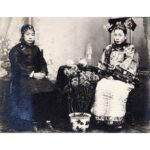Photography Celestial Globe and Quadrant in the Ancient Beijing Observatory
A black-and-white photograph showing two astronomical instruments on the platform of the Beijing Gu Guanxiangtai Observatory 北京古觀像台. Most of those still in existence today, including the ones in the photo, were made by the Jesuits in the 17th and 18th centuries. The celestial globe (tiantiyi 天體儀), had more than 60 uses. It was used mainly for manual calculation and coordination of the three coordinate systems: ecliptic, equatorial, and horizontal, and also to show the visible positions of the sun, moon and stars in relation to the Earth. The globe weighs 3,850 kilograms, is 2,735 metres high and has a radius of almost 2 metres. Nearly 1,900 stars of the northern and southern celestial hemispheres, made of gold-plated copper, are mounted on the globe. These are divided into 282 constellations. The ring above the globe marks the meridian, and the ring parallel to the ground marks the horizon. It has the correct inclination of the celestial axis and a clock mechanism.
The ... more
A black-and-white photograph showing two astronomical instruments on the platform of the Beijing Gu Guanxiangtai Observatory 北京古觀像台. Most of those still in existence today, including the ones in the photo, were made by the Jesuits in the 17th and 18th centuries. The celestial globe (tiantiyi 天體儀), had more than 60 uses. It was used mainly for manual calculation and coordination of the three coordinate systems: ecliptic, equatorial, and horizontal, and also to show the visible positions of the sun, moon and stars in relation to the Earth. The globe weighs 3,850 kilograms, is 2,735 metres high and has a radius of almost 2 metres. Nearly 1,900 stars of the northern and southern celestial hemispheres, made of gold-plated copper, are mounted on the globe. These are divided into 282 constellations. The ring above the globe marks the meridian, and the ring parallel to the ground marks the horizon. It has the correct inclination of the celestial axis and a clock mechanism.
The quadrant (xiangxianyi 象限儀), which was the main angle-measuring instrument until the invention of the telescope, was used to determine the distance between the celestial bodies and the horizon. It weighs 2,483 kilograms, and is 3,611 metres high. The main part of the instrument is the quadrant itself, in the form of a quarter of a circle decorated with a dragon flying over the clouds. Like the celestial globe, its straight vertical side marks the zenith or apex and the nadir or base. The horizontal side is parallel to the horizon. The circle connecting the horizontal and vertical sides is the measurement axis along which the pointer moves. The quadrant can rotate 360 degrees around its vertical axis. The instruments are two of eight astronomical measuring instruments currently exhibited in the observatory – now a museum.
One of the important officials of the Imperial Observatory was the Jesuit missionary of Slovenian origin, Ferdinand Augustin Hallerstein (1703–1774) with the Chinese name Liu Songlin 劉松齡. His contribution and legacy are very extensive. Among other things, he was head of the court department of astronomy and mathematics. He became an official or mandarin of the 3rd degree, a title rarely given to foreigners. Hallerstein is buried in the Jesuit church of Zhalan Mudi 柵欄墓地 in Beijing.
The Old Beijing Observatory is one of the few observatories from the period before the invention of the telescope that have survived to the present day. The site covers 10,000 square metres with a main brick platform measuring 40 by 40 metres and 15 metres high. Today, the observatory is a museum open to the public. It was built during the reign of Emperor Kangxi 康熙 (reigned 1661–1722) – on the foundations of a 12th-century precursor. Renovations were carried out under the supervision of the Flemish Jesuit and missionary Father Ferdinand Verbiest (1623–1688). In 1900 the observatory was looted by the French invaders, but in 1902 the instruments were returned “to their place”. In 1956 the observatory became a museum.
The photograph is the 164th of 449 photographs of Beijing and its surroundings in the album of Ivan Skušek Jr., purchased during his stay in Beijing (1914–1920). In the handwritten inventory of the album, the photograph is referred to as Sternwarte: Himmelsglobus und Mond-Winkel. It also appears in other photo collections. (DZ, MV)





































Do you have a comment or additional information about the subject?